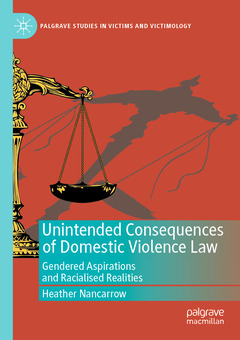Unintended Consequences of Domestic Violence Law, 1st ed. 2019 Gendered Aspirations and Racialised Realities Palgrave Studies in Victims and Victimology Series
Auteur : Nancarrow Heather

This book addresses the intersection of two current major concerns in Australia: law and justice responses to domestic violence - including harsher punitive measures - and the over-representation of Indigenous Australians in the criminal justice system, which are similar concerns in New Zealand, Canada and the US. Nancarrow re-conceptualises typologies of violence and provides a means of understanding and explaining female use of violence without undermining the hard-won gains of the women?s movement. It does, however, argue for a paradigm shift, which has implications for every aspect of the system we have built to stop men?s violence against women (law, police policy and practice, counselling and advocacy for victims, and interventions for those who perpetrate violence). The book is based on quantitative and qualitative research and explores the nature of Indigenous intimate partner violence andthe types of violence that domestic violence law sought to address.
Includes interviews with police prosecutors and domestic violence support workers
Offers an intersectional gender/race analysis by comparing Indigenous and non-Indigenous men’s and women’s experiences and contexts of domestic violence, and the application of domestic violence law to these cases
Appeals to those in the fields of law and justice policy and practice
Date de parution : 09-2020
Ouvrage de 245 p.
14.8x21 cm
Disponible chez l'éditeur (délai d'approvisionnement : 15 jours).
Prix indicatif 63,29 €
Ajouter au panierDate de parution : 09-2019
Ouvrage de 245 p.
14.8x21 cm
Disponible chez l'éditeur (délai d'approvisionnement : 15 jours).
Prix indicatif 89,66 €
Ajouter au panier

